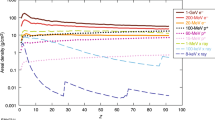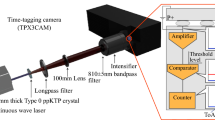Abstract
Electron range. In a recent note1, R. W. Berriman reported on a new photographic emulsion with which electron tracks can be recorded. Attempts have been made to relate energy and range of electron tracks in this type of photographic material, referred to as the NT2a plate. The electron tracks were obtained by exposing the plates to heavily filtered X-rays generated at increasing kilovoltages. The tracks were scanned under the microscope, and the number of grains of each track counted was plotted against the frequency of tracks. The curves so obtained show a shift of the maximum frequency towards greater numbers of grains with increasing kilovoltage. In a few cases where the tracks were at almost glancing angle to the plane of the plate, length measurements of the curved path of tracks were made. The maximum number of grains and lengths of tracks for each kilovoltage are shown in the accompanying table (columns 2 and 3).
This is a preview of subscription content, access via your institution
Access options
Subscribe to this journal
Receive 51 print issues and online access
$199.00 per year
only $3.90 per issue
Buy this article
- Purchase on Springer Link
- Instant access to full article PDF
Prices may be subject to local taxes which are calculated during checkout
Similar content being viewed by others
References
Berriman, R. W., Nature [161, 432 (1948)].
Schönland, Proc. Roy. Soc., A, 104, 235 (1923); 108, 187 (1925).
Varder, Phil Mag., 29, 726 (1925).
Williams, E. J., Proc. Roy. Soc., A, 130, 310 (1931).
Author information
Authors and Affiliations
Rights and permissions
About this article
Cite this article
HERZ, R. Electron Tracks in Photographic Emulsions. Nature 161, 928–929 (1948). https://doi.org/10.1038/161928a0
Issue Date:
DOI: https://doi.org/10.1038/161928a0
This article is cited by
Comments
By submitting a comment you agree to abide by our Terms and Community Guidelines. If you find something abusive or that does not comply with our terms or guidelines please flag it as inappropriate.



